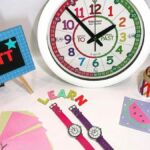
How to help children and adults with dyscalculia to tell the time
Learning how to tell the time can be a challenge for any child, or adult for that matter. As well as being a requirement as part of the primary curriculum, being able to identify time and understand time as a concept is an important part of a child’s development and growth. For those who have dyscalculia, learning how to tell the time is even more challenging, and often requires special accommodations or teaching techniques. It is often hard for parents and caregivers to know how to help a child with dyscalculia learn to tell the time, as the child will engage with clocks and numbers in a different way. Time teaching resources, such as our clocks, games and aids, can make a real difference to their learning, as well as supporting adults with dyscalculia.
What is Dyscalculia?
Dyscalculia is often referred to as ‘mathematical dyslexia’, and is a condition that involves difficulty with numbers or mathematics. The most common symptoms of dyscalculia include difficulty performing calculations, counting backwards and understanding place value, as well as weak overall mental arithmetic skills and difficulty remembering basic mathematical facts.
For those with dyscalculia, many daily activities involving numbers become difficult, such as addition and subtraction, paying for goods with cash, and telling the time. There are several practical ways that parents can help a child who struggles to tell the time due to dyscalculia, and one of the most effective is to invest in teaching products and techniques to use at home and in the classroom.
Many of these products can also support adults with dyscalculia who may struggle to tell time, as they are designed to simplify the timetelling process for people of all ages.
How to help a child with dyscalculia
If your child has dyscalculia, or is demonstrating symptoms of dyscalculia, or you yourself require assistance, then our time telling range offers fun and useful assistance in learning how to tell the time.
Clocks
For many children with dyscalculia, the hand placement and basic design of analogue clocks can be very confusing. On almost every clock, there are only 12 numbers, meaning that up to 80% of the information needed to learn how to tell the time is missing. This places those with dyscalculia at an extreme disadvantage and makes telling time a difficult task for people of all ages. Our EasyRead clocks include a clear breakdown of all 60 minutes and can be read in 3 simple steps that can be learnt quickly and memorised for a lifetime, supporting those with dyscalculia from childhood to adulthood.
This will be particularly effective when teaching your child how to recognise numbers that are close to the hour. For many children with dyscalculia, 7:55 and 8:05 will be almost identical to 8:00, so our clocks reduce the confusion around these numbers and will make learning digital time much easier later on.
Our clocks also feature bold and colourful designs and easy to read numbers to encourage engagement. Visual models, as well as engaging designs, break down the wider concept of time and make it much more accessible and easier for people with dyspraxia to tell time by combining numbers and colours in straightforward systems.
Games and Aids
Educational and fun activities are always an effective learning tool, and children with dyscalculia respond particularly well to objects and games that make time telling simple and engaging rather than complicated. Our games encourage children to interact with time and numbers outside of the clock and makes learning time fun and engaging for anyone at any age!
Our games make the challenge of telling time rewarding, rather than daunting, and can be enjoyed during family time or playtime. Many children with dyscalculia often feel confused or embarrassed when learning to tell the time, particularly in school, and our games are a low-stakes alternative to tests or worksheets. If you yourself have dyscalculia, then these games will be an effective and fun way to improve your own time telling abilities whilst supporting your child.
Finding the perfect clock
When teaching young children with dyscalculia to tell the time, or interacting with an adult with dyscalculia, the best resource you can use is a positive and patient mindset. Finding a strategy and resources that work for your child will encourage them to tackle new challenges and boost their confidence when it comes to completing other number-related activities.
To find out more about the features and benefits of our EasyRead clocks, or to discover your preferred time teaching method, please click here.